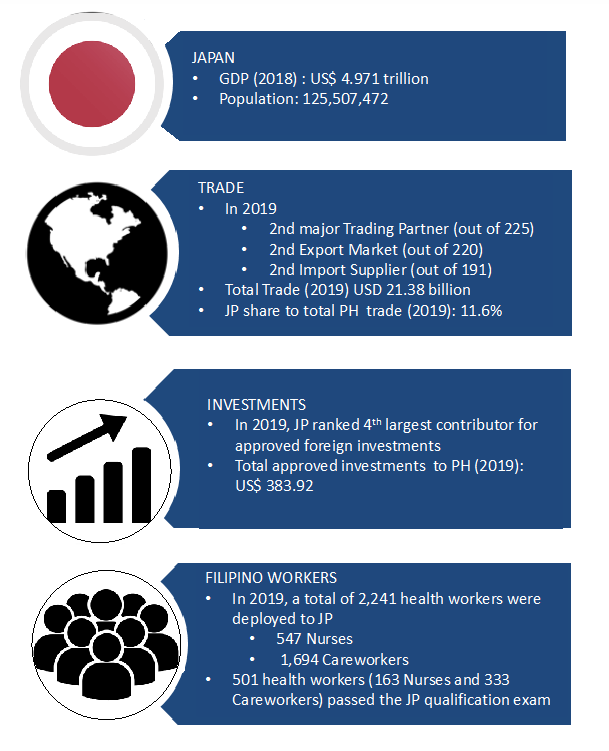Philippines-Japan Economic Partnership Agreement (PJEPA)
The PJEPA is the first bilateral free trade agreement of the Philippines. It was signed in Helsinki, Finland by then President Gloria Macapagal-Arroyo and former Prime Minister Junichiro Koizumi on 9 September 2006. The Philippine Senate concurred with the ratification of the PJEPA on 8 October 2008 and the Agreement officially entered into force on 11 December 2008.
Coverage
The PJEPA covers, among others, trade in goods, trade in services, investments, movement of natural persons (MNP), intellectual property (IP), government procurement (GP), competition, and improvement of business environment (IBE).
Benefits from the implementation of the PJEPA
Upon the entry of force of the PJEPA in 2008, balance of trade gradually improved in favor of the Philippines. Based on an 8-year average before and after the entry of force of the PJEPA, trade balance improved by USD 32.2 billion from USD-7.51 billion pre-PJEPA (2001-2008) to USD 27.64 billion post-PJEPA (2009-2016). Moreover, total trade improved by 19% from USD 115.99 billion to USD 137.96 billion resulting to Japan becoming the Philippines’ largest export market. In 2019, Japan remained to be the Philippines’ major trading partner, ranking 2nd out of 225 countries with total trade amounting to USD 21.38 billion. It is the Philippines’ 2nd export market (out of 220) and 2nd import supplier (out of 191).
In terms of investments, a 146.7% amounting to PHP260.81 million surge in approved investments from Japan was recorded by investment promotion agencies (IPA) – from PHP 117.83 million pre-PJEPA to PHP 438.64 million post-PJEPA. In 2019, Japan ranked as the 4th largest contributor for approved foreign investments to the Philippines amounting to PHP 19.89 million with the manufacturing, real estate activities, and electricity, gas, steam and air conditioning supply industries contributing to the larger part of investments form Japan.
For movement of natural persons (MNP), Japan has historically maintained very restrictive entry requirements for foreign professionals. In 2001-2006, the only occupational categories Filipinos were able to substantially fill were choreographers and dancers and composers, musicians and singers – 139,521 and 177,457 deployed OFWs, respectively. With the entry of the PJEPA, Filipino nurses and careworkers were allowed entry to Japan. As of 2019, a total of 2,241 health workers – 547 nurses and 1,694 careworkers – were deployed under the PJEPA program since it started in 2009. Per POEA records, 501 health workers (168 nurses and 333 careworkers) already passed the qualification exam in Japan.
PJEPA General Review
Based on Article 161 of the PJEPA, the Philippines and Japan (Parties) shall undertake a General Review of the Agreement and its implementation and operation in 2011 and every 5 years thereafter, unless otherwise agreed by both Parties. In view of this, the General Review was commenced in 2011 at the convening of a Joint Committee Meeting chaired by DTI and Japan’s Ministry of Foreign Affairs (MOFA). Under the PJEPA General Review, the Philippines is continuously pursuing for tits offensive interest in (a) improving of market access through tariff elimination or reduction for our top major export products such as fresh bananas and pineapples, fish products, prepared foodstuff and leather products, among others; (b) improvement of rules of origin (ROO) for major export products; and (c) creation of a framework for the entry of additional categories of skilled Filipino workers to Japan.
The latest talks on the General Review were held during the 9th PJEPA Joint Committee Meeting (JCM) and Sub-Committee Meetings last 15-17 April 2019 in Makati City, Philippines. Eleven (9) Sub Committees convened back to back with the 9th JCM to discuss improvements in implementation and operation and negotiate for improved market access: Trade in Goods, Rules of Origin, Customs Procedures, Trade in Services, Investments, Movement of Natural Persons, Intellectual Property, Government Procurement, and Competition. Additionally, (2) two working groups were created to discuss the consideration to include E-Commerce and MSME in the PJEPA.
Important Documents
- Philippines-Japan Economic Partnership Agreement
- Annexes
- Annex 1 – Tariff Reduction Schedules
- Annex 2 – Product Specific Rules
- Annex 3 – Minimum Data Requirement for Certificate of Origin
- Annex 4 – Sectoral Annex on Electrical Products
- Annex 5 – Financial Services
- Annex 6 – Schedule of Services Commitments
- Annex 7 – Reservations for Existing and Future Measures
- Annex 8 – Specific Commitments for Movement of Natural Persons
- Implementing Agreement Between the Government of Japan and the Government of the Republic of the Philippines Pursuant to Article 12 of the Agreement Between Japan and the Republic of the Philippines for an Economic Partnership
- Tariff Commission: Tariff Finder
- Japan Custom Website: Tariff Schedule
- Japan WTO Member Trade Profile
- Japan WTO Trade Policy Review 2017
Related Data/Statistics

Source: Trade and Investment data: PH-JP TIR and ITC Trademap
Filipino Workers: DOLE data
For more details, contact the Bureau of International Trade Relations – Bilateral Relations Division (BITR-BRD) at BRD@dti.gov.ph.


